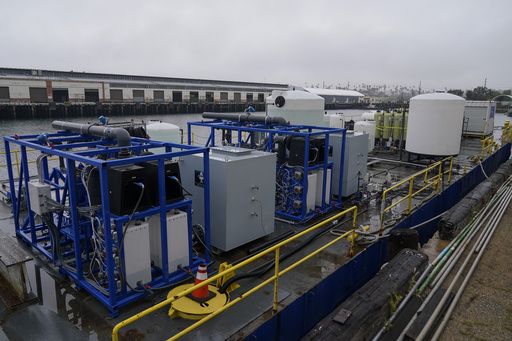Boeing signs alternative fuel deal with Los Angeles startup to cut carbon footprint
A demonstration site of a seawater-based carbon removal system is set up on a barge, Wednesday, April 12, 2023, in San Pedro, Calif. Equatic, a Los Angeles startup that is designing facilities to remove carbon dioxide from the ocean says it has struck an agreement with Boeing to provide the aerospace giant with a byproduct of the process to help it cut emissions from planes. (AP Photo/Ashley Landis, File)
SAN DIEGO (AP) — As the aviation industry seeks to cut its carbon footprint, Boeing has just signed a deal to help its quest for a sustainable jet fuel, and it’s tied to an unlikely source: the ocean.
The aerospace giant has signed a deal with a Los Angeles-based startup to buy hydrogen that will be produced by facilities designed to cleanse seawater of carbon dioxide so the ocean can absorb more of that greenhouse gas contributing to global warming.
By absorbing 30% of carbon dioxide emissions since the Industrial Revolution, the ocean has acted as a giant carbon sink and been a crucial buffer in protecting people from even worse effects of early climate change.
Equatic said Boeing has agreed to pre-purchase the hydrogen, which will be produced when it employs the carbon-removal system — developed by University of California Los Angeles engineering faculty — at facilities at the port of Los Angeles and Singapore. It is slated to be up and running in 2025. Researchers have been testing the system at demonstration sites in both locations.
The green hydrogen could then be used as a component in sustainable aviation fuel. Aviation currently accounts for about 2.5% of worldwide emissions of carbon dioxide.
Equatic’s Chief Operating Officer Edward Sanders acknowledged that Boeing’s backing is a huge boost for an initiative that is just getting off the ground.
“With the deal with Boeing, they recognize that hydrogen will be useful for them,” he said. “And we’ve had some very encouraging conversations with other industries who also need hydrogen who have plans to do it through the carbon-neutral generation of green hydrogen.”
To help keep global warming under 1.5 degrees Celsius, the world’s largest association of airlines, the International Air Transport Association, has set a goal for the air transport industry to reach net zero carbon emissions by 2050. President Joe Biden’s administration wants all kerosene-based jet fuel to be replaced with sustainable fuel by 2050.
While other forms of transportation are increasingly being electrified, making large, battery-powered planes has presented a costly challenge and many in the aviation industry are instead exploring replacing fossil fuels with sustainable fuels, which would not require major technical modifications to the aircraft. The world’s first synthetic kerosene plant opened in Germany in 2021.
Equatic said it will remove 62,000 metric tons of carbon dioxide for Boeing and supply the aerospace company with 2,100 metric tons of hydrogen under its five-year agreement. The companies declined to provide details about how much revenue would be generated or other details of the deal.
Sheila Remes, Boeing’s vice president of environmental sustainability, said in a statement that “reaching aviation’s sustainability goals will require a multi-faceted approach and Boeing sees significant opportunity in Equatic’s technology.”
Equatic’s process sends an electrical charge through seawater that then sets off a series of chemical reactions that trap the greenhouse gas into a solid mineral, while also producing hydrogen. The seawater is then returned to the ocean and can pull more carbon dioxide out of the air, while the solid mineral, which contains calcium carbonate, can then settle to the sea floor.
Revenue from selling hydrogen, as well as carbon credits companies can claim to balance out their pollution, will be applied toward Equatic’s plans to open facilities.
According to the UCLA team that developed the technology, at least 1,800 industrial-scale facilities would be needed to capture 10 billion tons of atmospheric carbon dioxide per year, but fewer could still make a dent.
The aim is to remove the carbon at a cost well below $100 per metric ton, the company has said. It added that the hydrogen would be produced at less than $1 per kilogram, which would be substantially less than the current cost of cleanly-produced hydrogen.
Equatic said it aims to reach 100,000 metric tons of carbon removal per year by 2026 and millions of metric tons per year by 2028.
Copyright 2023 The Associated Press. All rights reserved


